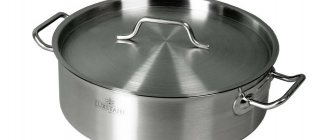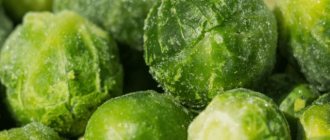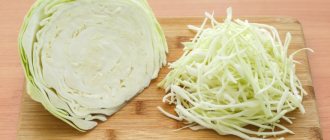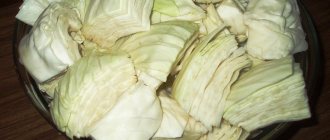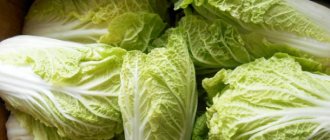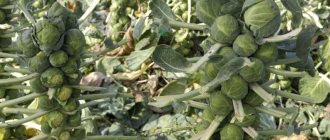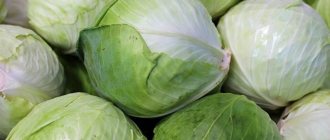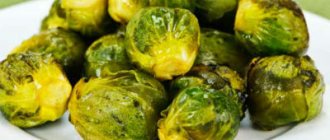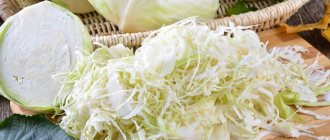Autumn-winter is the most favorable season for sauerkraut. By this time, the vegetable is ripe and completely ready for further use. For pickling, you need to prepare cabbage and other vegetables, spices, a sharp knife, a shredder, pressure and, of course, containers. Is it possible to ferment cabbage in a plastic bucket? This is exactly what the article will discuss.
What to ferment cabbage in?
You cannot find a more suitable container than a wooden barrel. But it is difficult to store it in an apartment, and it will turn out to be too much cabbage. Another problem is that it is difficult to buy a container of the required volume and made of good wood.
A large enamel pan is suitable for fermentation. Make sure it is free of chips. Otherwise, you risk spoiling the cabbage: it may acquire an unattractive gray color and an unpleasant taste.
If you need a small amount of sauerkraut, then glass containers are suitable for this: a three-liter jar or a five-liter bottle.
Under no circumstances should you take containers made of metal, such as aluminum or stainless steel. Typically, during fermentation, the acid reacts with the metal. Cabbage absorbs everything and loses its taste and usefulness. Many people wonder: is it possible to ferment cabbage in a plastic bucket?
Plastic buckets designed for cold food products are now being produced. Some sell fermented milk products, mayonnaise, salted fish, etc. But is it possible to ferment cabbage in a plastic bucket, because during fermentation, acid appears, which, one way or another, reacts with the plastic? Sauerkraut absorbs smell and unknown elements. And buckets are not always made of the right plastic. Other impurities may also be included in the composition. So, by using low-quality containers, we risk not only ruining the taste of the dish, but also our health.
But what to do if there is no other suitable container? Is it possible to ferment cabbage in a plastic bucket? Yes, you can, but you just need to listen to the following recommendations:
- Be sure to buy a plastic bucket for food grade use only. Feel free to ask the seller for a certificate to ensure the quality of your purchase.
- Buy buckets that are not made of colored plastic. It is best to take a colorless one, like a nylon lid for a jar, or a white one, like the one they sell sour cream in stores.
- Wash the new bucket several times. Then fill up with water and leave for a day. Then dry it in the open air.
- You can ferment cabbage in a plastic bucket by placing a plastic bag in it. Use only a food grade bag. Cling film used to cover the inside of the bucket is also suitable.
- You need to ferment the cabbage in a plastic bucket until fully cooked. Then it is better to transfer it into glass jars. Tamp the cabbage and pour in the resulting juice.
Preparing the bucket
Experts and experienced housewives believe that in any case, the taste of cabbage pickled in a plastic bucket will not be as rich and attractive as if it were pickled in a metal or glass container. But metal is different from metal. To pickle cabbage, exclusively enamel buckets are used.
Attention! Do not use aluminum or stainless steel utensils for salting. The acid reacts with the exposed metal and the cabbage turns gray and unfit for consumption.
If you don’t have any other bucket at hand other than a plastic one, you can prepare it for salting as follows:
- The new bucket should be washed several times with soda, and then, filling it with water, leave it like that for 24 hours. Then dry it thoroughly in the sun. This recommendation, however, applies to any new dishes, including enamel buckets.
- To reduce the contact of salted vegetables with the walls of the bucket, you can line the inside with food-grade plastic or place a plastic bag inside.
- In any case, it makes sense to use a plastic bucket only for the pickling process. After the cabbage has fermented, it is better to transfer it to glass jars for storage.
If you use an enamel bucket for pickling, it is important to check that there are no chips on the bottom or walls. Otherwise, the workpiece may acquire an unpleasant taste and color.
Choosing cabbage for pickling
How to ferment cabbage in a plastic bucket? First you need to choose the right vegetables. Mid-late and late varieties of cabbage are the most suitable for harvesting for the winter. They contain sugar, which is necessary for the fermentation process. Experienced housewives recommend taking those heads of cabbage that have been caught by a slight frost, and they have been lying around for a while. Then the cabbage loses its bitterness. But avoid frozen vegetables.
For pickling, you need to choose intact and tight heads of cabbage. Leaves must be free of rot and wormholes. It is recommended to take large heads of cabbage. The result is more shredded leaves and less waste.
How much to ferment cabbage? Which cabbage to choose
Previously, the cabbage harvest began to be harvested on Exaltation (September 27). On this day, cabbage and dishes made from it were always present on the table. Now we can say with great confidence that for pickling it is better to use late or mid-ripening white cabbage with strong elastic leaves, which means it is better to ferment cabbage in the fall. Cabbage heads should be dense, white when cut and have a thin leaf and a small stalk (1/3 of the height of the head). They must still accumulate at least 4% sugars by the time of harvesting.
The following varieties are suitable for fermentation: Slava, Garant, Countess, Moskovskaya late, Belorusskaya, Triumph, Flibustyev, Zimnyaya Gribovskaya, Podarok, Snow White.
Mid-late and late varieties and hybrids of white cabbage, which stand on the vine for a long time and only become prettier as a result, are best harvested after the first frost - the ripe heads caught in the frost become more sugary.
There is another interesting information about sauerkraut. Summer residents, this is for you! Sauerkraut is best made from... freshly harvested cabbage: between 24 and 48 hours after harvest. This is due to the fact that the population of lactic acid bacteria, which, according to the laws of nature, lives on the surface of the leaves, begins to die off during long-term storage. Namely, these bacteria are the main influencers in the fermentation process.
BY THE WAY: cabbage fermented with whole heads of cabbage will turn out tender and elastic, and the brine will be more tasty if you sprinkle a handful of crushed corn between the rows of heads of cabbage.
What can you add to sauerkraut?
Fermentation is impossible without salt. It’s best to take regular table food, and even coarsely ground. If you are starting fermentation for the first time, then you should adhere to the proportions indicated in the recipe. Experienced housewives salt by eye and to taste, which suits the needs of the family.
Bay leaves, black peppercorns, sweet and hot peppers, horseradish, apples, cranberries, pumpkin, lingonberries, plums, currant leaves and even oak bark are added to sauerkraut. And of course, there should be carrots, cut into thin slices or shredded on a coarse grater. It gives cabbage its flavor and crunchy properties.
To change the color, some housewives add sliced beets to the cabbage or add its juice. All vegetables or fruits in sauerkraut must be cut into strips.
How and where to cut a cabbage head
A wide and long chef's knife is suitable for cutting cabbage; it must be well sharpened. Sometimes they use a special cut for cabbage, but it cuts the leaves too finely and they are not very suitable for pickling.
You can find a shredder board, just remember that its knives are very sharp and can easily get hurt. Therefore, you need to learn how to use it and be extremely careful.
It is best to cut cabbage on a wide table or large wooden cutting board. The chopped leaves can be left here or poured into an enamel bowl, where we will mix all the ingredients.
There are several ways to cut cabbage. In most cases, the head of cabbage is cut in half and then chopped not too finely. You can also cut the cabbage into squares. There are ways to ferment quarters, halves and even whole heads of cabbage.
Shredded cabbage is combined with salt, spices, carrots and other selected ingredients. Mix thoroughly with your hands and leave for some time until the first juice appears.
Technology for laying and storing sauerkraut
Is it possible to ferment cabbage in a plastic bucket? Yes, sure. You just need to adhere to a certain technology. We begin to place the prepared vegetable mixture into the container. The bottom of the container should be lined with washed cabbage leaves. Next, add the cabbage and compact it tightly. As a rule, a wooden rolling pin is used. But you can do it with your hand. We tamp each layer of the mixture until liquid appears on the surface. Cover the top with a cabbage leaf and white natural fabric (you can use a piece of gauze). They also use a wooden circle, plate or lid, which is smaller than the diameter of the container neck, but does not leave a large distance from the walls. Be sure to put oppression on top. A stone, weight (wrapped in cling film) or a container of water is suitable for this.
We leave the container with cabbage for three to four days in a room where the temperature is not less than 17 and not more than 22 degrees. At this temperature, cabbage fermentation occurs during this time. As a result of this process, a lot of juice will be released, so place the container in another container into which the liquid will drain.
Gas bubbles and foam on the surface are considered to be indicators of proper fermentation. The foam needs to be collected from time to time. In order for the cabbage to sour evenly and for gas to escape, it must be pierced with a long wooden stick. This way you will get rid of the bitter taste of sauerkraut.
The cessation of the release of liquid and gas indicates the completion of fermentation. It's worth tasting the product. Cabbage should have a pleasant sour taste, slightly orange color and a specific aroma.
The container with sauerkraut is placed in a cooler place and stored at a temperature of 0 to 5 degrees. Some housewives practice freezing sauerkraut. The finished product is placed in freezer bags and placed in the freezer. To use, just defrost the cabbage. It is worth noting that neither taste, aroma, nor beneficial properties are lost.
With horseradish root
The appetizer turns out to be piquant and bright in taste. Cabbage, sauerkraut for the winter, crispy in a bucket, is done quickly. All family and friends will like it. The amount of ingredients is calculated for one 10-liter bucket.
Products:
- cabbage - 8 kg;
- carrots - 0.4 kg;
- rock salt - 240 g;
- horseradish root - 50 g.
Sauerkraut with horseradish
- Rinse the starter container thoroughly and pour boiling water over it to eliminate pathogenic microflora. Peel the ingredients, rinse and cut into small slices. Place whole cabbage leaves on the bottom and on top.
- Clean the forks, remove the stalk and chop into strips, but not too thin. Otherwise, the vegetable will not be as crispy as you would like.
- Rinse the peeled carrots, cut into slices and combine with cabbage in a separate bowl. Sprinkle with salt and mash a little. Spread the vegetable mixture tightly into the prepared bucket. You can compact it with your hands or a wooden masher. Cover the top with clean cabbage leaves. Place under pressure: first a wooden board, and then a 3-liter jar of liquid.
- Place the container with contents in a cool place (temperature up to 18 degrees). Remove the press daily and pierce it in several places. If foam forms on the surface, carefully remove. If these steps are not performed, the cabbage will spoil.
- Vegetables are fermented for 10 days, after which the container is taken out into the cold, where it will be stored all winter.
The main thing is not to overfreeze the salad, otherwise the preparation will not be as tasty.
Sauerkraut in a plastic bucket: recipe
To get 10 kilograms of shredded cabbage, you need to take 12 kilograms of whole cabbage.
We separate the top leaves from the head of cabbage, divide them in half and cut out the stalk. Shred the cabbage and mix with chopped carrots (300-400 grams), salt (no more than 250 grams), add bay leaf, as well as other vegetables or fruits.
Place cabbage leaves at the bottom of the bucket. Pour the mixture on top and tamp so that liquid appears above the layer. Cover the top of the cabbage with leaves, cover with gauze and place a weight.
The fermentation process will last from 3 to 5 days. Don’t forget to collect the foam and pierce the cabbage with a stick to the very bottom. Every day you need to wash the gauze and wash the load. Store ready-made sauerkraut in a cool place.
How to make sauerkraut
Place the shredded cabbage and grated carrots (or whatever vegetables you're using) into a clean bowl and stir to combine.
If you plan to ferment a lot of cabbage, do not cut it all at once: it will be difficult to mix. Better to cook in batches.
Sprinkle the vegetables with salt and rub them with your hands. This is necessary for the cabbage juice to be released.
Start placing the cabbage in a well-washed and treated with boiling water starter container. Place the cabbage in batches and press down with your hands or a wooden masher.
If you ferment cabbage in a jar, cover it with a regular lid or a lid with holes. It is impossible to completely close the jar, since the gas released during fermentation must come out.
If you ferment cabbage in a bowl or pan, cover it with clean (preferably boiled) gauze or washed cabbage leaves, place a clean plate and weight on top: a jar of water or a clean stone will do.
If you are using a small container, be sure to place it in some container to catch any juice that is released.
botanichka.ru
Sauerkraut should be fermented at room temperature (19–22 °C). You can put it in a warmer place. This will speed up the fermentation process and the appetizer will cook faster.
A few hours after laying, check whether the juice has covered all the cabbage. If not, add cold boiled water.
Cabbage is fermented for two to seven days. Every day you need to pierce it to the very bottom with a clean wooden stick to release the gas. Otherwise the cabbage will taste bitter. If you ferment cabbage in a jar, pierce it carefully: the glass may burst. It is also necessary to remove the foam that appears on the surface every day.
By the end of fermentation, gas evolution stops, foam disappears from the surface, the brine becomes light, and the cabbage itself acquires a pleasant sour-salty taste. In order not to miss this moment, check and try it every day.
Cabbage can be fermented without salt. To do this, simply fill it with cold boiled water and leave it under pressure.
But in this case, the shelf life is significantly reduced, since salt is a preservative.
Recipe for sauerkraut in a plastic bucket with whole heads of cabbage
For this fermentation method, you need to take dense and small heads of cabbage. Remove the top leaves and carefully cut out the stalk. Place the prepared heads of cabbage in a container, line the bottom with oak bark, and place currant and cherry leaves on top of the cabbage.
Prepare the brine: dissolve 500-600 grams of salt in 10 liters of water. Pour over the cabbage so that the liquid completely covers the heads of cabbage. Cover with gauze, wooden circles, and apply pressure.
How to salt cabbage in pieces in a plastic container
To ferment cabbage, it is not at all necessary to finely chop it. It turns out very tasty if you pickle it in large pieces. To do this you need:
- remove the top leaves of the head of cabbage, wash it, cut it in half, and then into two more parts. Remove the stalk, then cut these parts into pieces of your preferred size;
- Line the bottom of the prepared plastic bucket with oak bark or cabbage leaves. Then fill the container with chopped pieces of cabbage and compact them slightly;
- For flavoring, place cherry or currant leaves on top. And cover with cabbage leaves on top;
- prepare a brine at the rate of 500-600 g of salt per 10 liters of water and pour it over the pieces of cabbage placed in a bucket to completely cover them with liquid;
- Cover the top of the cabbage with a clean natural cloth (linen, cotton) or gauze, then with a wooden circle or a suitable sized plate, and then apply pressure.
Recipe for sauerkraut with lingonberries (cranberries)
Chop 10 kilograms of cabbage, add 400 grams of carrots cut into strips, add salt (50-100 grams) and mix thoroughly.
Pour the mixture into a container, compact each layer and sprinkle with lingonberries (cranberries). In total you will need 700-800 grams of berries. The last layer should be cabbage. Cover with a cabbage leaf, cloth, plate and place pressure.
Every day, carry out water procedures for oppression and fabric, pierce the cabbage with a stick and collect excess foam. This recipe is suitable for sauerkraut with apples or pumpkin.
Cabbage pickled in its own juice is not only nutritious, but also very healthy. It contains vitamins B and C, which are stored for a long time. Don't be afraid to ferment cabbage. The suggested recommendations and secrets will eliminate mistakes, and the cabbage will turn out very crispy and aromatic.
